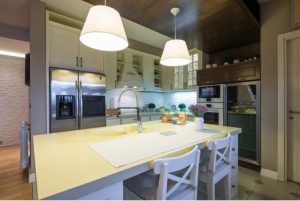California’s 2016 energy code calls for a number of changes to incorporate high-efficacy lighting into more homes across the state. High-efficacy lighting makes it possible for homes to use significantly less energy over time, so the goal of the 2016 energy code is to require more of this kind of residential lighting to bring overall efficiency up and energy use down. The energy code’s mandatory lighting requirements apply to all permanently installed lighting fixtures, and could impact you if you’re making improvements or changes at your home.
 The 2016 energy code has changed to require that all lighting installed in new residential construction be high efficacy lighting. The code no longer allows a mix of low and high efficacy lighting as was allowed in the 2013 energy code. All of the lighting requirements are mandatory requirements and there are no tradeoffs between lighting and other building features. Lighting is not part of any component package under the prescriptive method.
The 2016 energy code has changed to require that all lighting installed in new residential construction be high efficacy lighting. The code no longer allows a mix of low and high efficacy lighting as was allowed in the 2013 energy code. All of the lighting requirements are mandatory requirements and there are no tradeoffs between lighting and other building features. Lighting is not part of any component package under the prescriptive method.
There are a variety of different high efficacy light sources that are acceptable under the latest lighting requirements. These sources include pin-based linear or compact fluorescent lamps (CFLs) that rely on electronic ballasts, pulse-start metal halide lamps, high-pressure sodium lamps, GU-24 sockets containing light sources other than LEDs, inseparable SSL (Solid State Lighting) luminaries that are installed outdoors, and inseparable SSL (Solid State Lighting) luminaries that contain colored light sources and are installed to provide decorative lighting, according to Energy Code Ace, a program of the California Public Utilities Commission.
There are also several high-efficacy light sources that can be used in tandem with sensors or dimmers. These light sources include ceiling-recessed downlights, LEDs with integral sources, pin-based LED lamps and GU-24-based LED lights. The energy code no longer allows the use of vacancy sensors or dimmers to substitute for high efficacy lighting fixtures.
Additionally, there are specific guidelines relating to screw-based fixtures. Screw-based lighting must contain JA8 compliant light sources and recessed downlights in ceilings can’t have screw-based sockets. The 2016 energy code also calls for all outdoor lighting to be high efficacy, as well.
Outside of the changes tied specifically to the lighting, there are other factors homeowners must consider with regards to the electrical boxes and fixtures located within specific rooms of their homes. The number of blank electrical boxes that extend at least 5 feet above the floors in homes cannot outnumber the total number of bedrooms. These electrical boxes must also be connected to a dimmer, a fan speed control or a vacancy sensor. Finally, at least one lighting fixture in bathrooms, garages, laundry rooms and utility rooms must be connected to a sensor.
All of these requirements are designed to help homes become more energy efficient, and at Rick’s Energy Solutions, our goal is to show you how these kinds of requirements can be beneficial to you. Contact us at 707-578-5380 today to learn more about the recent 2016 energy code changes and the green home services we can provide for you.
